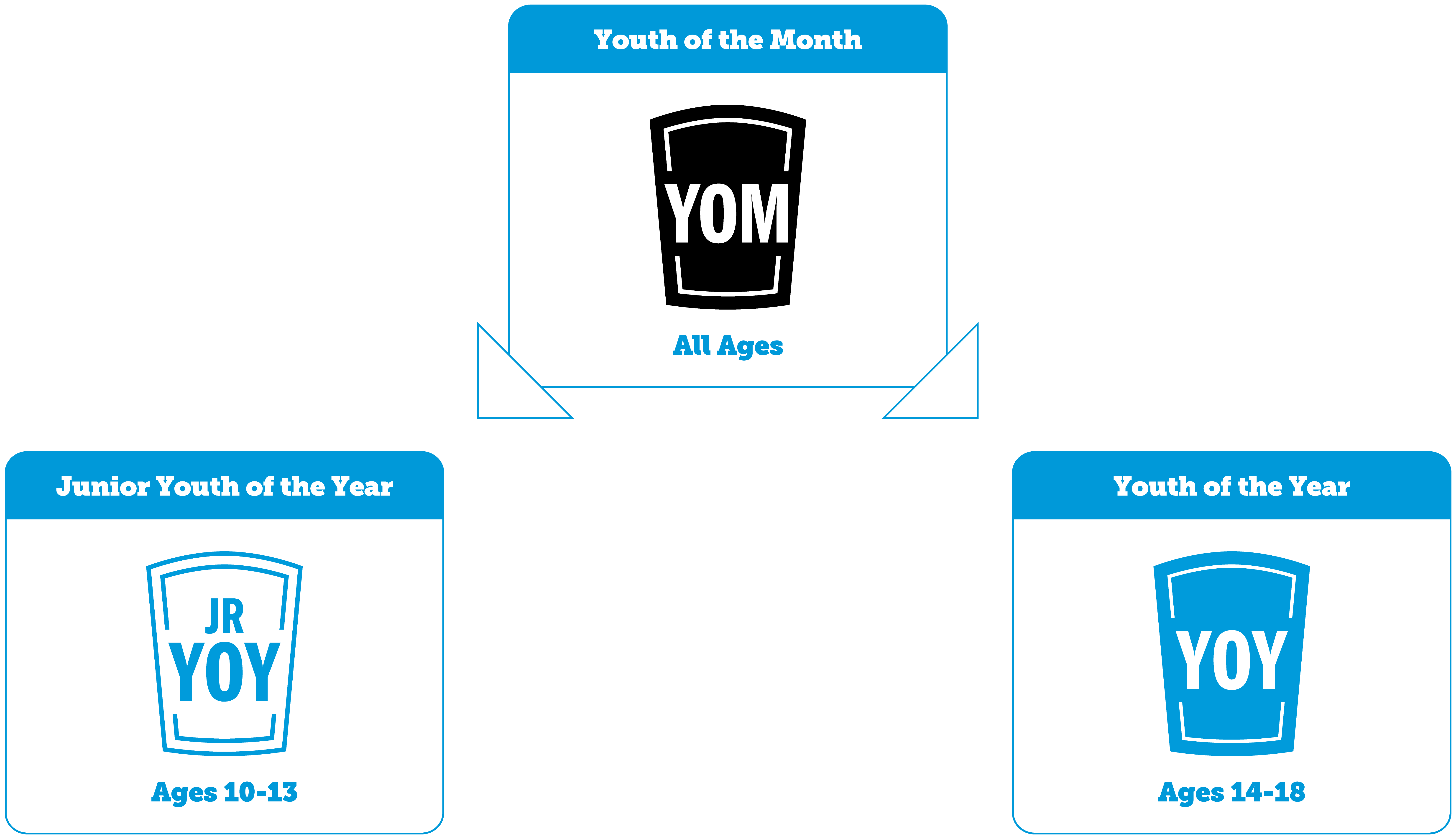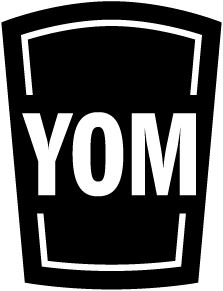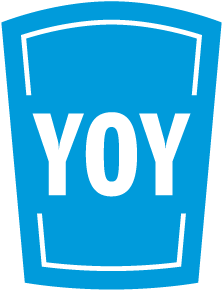
Youth of the Year: Leadership Development Targeted Program Guide
These sessions provide in-depth exploration of essential leadership skills and concepts – specifically for youth participating in Youth of the Year.

If you are part of a BGCA Organization, you can use your BGCA Account to access Club Programs.
I am part of a BGCA organization I am not part of a BGCA organization
These sessions provide in-depth exploration of essential leadership skills and concepts – specifically for youth participating in Youth of the Year.
Youth define leadership. They also recognize the fact that leadership ability can be developed.
Youth define where emotions come from. They also describe how feelings drive behavior. They identify the feelings they experience in response to various situations and their immediate reactions.
Youth define strengths and distinguish between strengths and skills. They identify their unique strengths. They also describe how their strengths can shape their life choices and lead them to be their best selves in the future.
Youth identify different aspects of their identity. They describe how identity shapes the way they view the world. They recognize the importance of seeing others’ identities in order to understand them.
Youth define self-advocacy. They explain strategies for self-advocacy. They demonstrate standing up for what they believe. Youth also advocate for an issue that is important to them personally.
Youth recognize the importance of nonverbal messages. They identify listening as the most important element of effective communication. They evaluate their own listening skills. They also set a goal to improve listening skills.
Youth recognize that people have thoughts, feelings and values that are not visible to others. Youth identify and interpret factors that influence the way someone responds to a situation.
Youth define bias, stereotypes, discrimination. They explain where biases come from. They describe strategies to confront bias toward them. Youth also describe strategies to confront their unconscious bias toward others.
Youth define conflict. They identify different types of conflict. Youth explain why the ability to resolve conflicts and bridge difference is important for this generation of leaders.
Youth define ally, advocate and activist. They describe what it means to be an advocate. They explain the process of advocating for a social or political issue.
Youth define social justice and advocacy. They describe the history of the Black Lives Matter movement. They identify why the issue is important
To give Clubs maximum flexibility, the following quick-start activities can be used at any time to build a basic understanding of leadership. They include a variety of experiences to address a range of interests and can be facilitated in 30 to 60 minutes with minimal leader preparation.
Activities are specifically designed to foster the following essential outcomes: 1) self-leadership, helping youth become aware of themselves and their emotions as a step toward personal growth and leadership; 2) leadership with others, enabling youth to understand their own perspective and the perspective of others and learn to communicate effectively as part of a team; and 3) leadership in the community, encouraging youth to take positive actions in the community that are informed by their self-knowledge and their ability to collaborate with others.
Leadership Outcomes | |||
Activity | Self-Leadership | Leadership With Others | Leadership in the Community |
| 1. Leadership Scramble |
| X |
|
| 2. From the Inside Out | X | X |
|
| 3. Your Goals Pyramid | X |
|
|
| 4. Framing Your Strengths | X | X |
|
| 5. Say “No” to Stereotypes | X |
| X |
| 6. Leadership Bingo | X | X |
|
| 7. Improv Night | X | X |
|
| 8. The Inequality Project | X | X | X |
| 9. Songs of Justice | X | X | X |
| 10. Cooperation Comics |
| X |
|
| 11. The World Is Bigger Than You! | X | X | X |
| 12. Plan a Social-Justice Project |
| X | X |
Activities in this guide are targeted to three different age groups: 1) ages 6-10 years; 2) ages 11-13 years; and 3) ages 14-18 years. Activities that are targeted to youth in several age groups include suggestions for adapting the experience to younger members.
Age Groups | |||
Activity | Ages 6-10 | Ages 11-13 | Ages 14-18 |
| 1. Leadership Scramble |
| X | X |
| 2. From the Inside Out | X | X |
|
| 3. Your Goals Pyramid | X | X |
|
| 4. Framing Your Strengths |
| X | X |
| 5. Say “No” to Stereotypes |
| X | X |
| 6. Leadership Bingo |
| X | X |
| 7. Improv Night |
| X | X |
| 8. The Inequality Project |
| X | X |
| 9. Songs of Justice |
| X | X |
| 10. Cooperation Comics |
| X | X |
| 11. The World Is Bigger Than You! |
| X | X |
| 12. Plan a Social-Justice Project |
| X | X |
The population of teens in the United States today is approximately 21 million. All young people have the potential to be leaders in schools, workplaces and communities, yet only a few are encouraged or given a chance to demonstrate leadership in meaningful ways. While there are plenty of opportunities for leadership development in the adult years, many successful leaders report that experiences they had early in their lives are what helped them in leadership roles as adults. What is clear is that leaders do not develop overnight; a lifetime of experiences strengthen an individual’s personal leadership as they mature and grow. Here are the advantages to educating young people in leadership.
What youth bring to leadership roles
What youth gain from leadership development
Since 1947, Youth of the Year has recognized and celebrated the extraordinary achievements of Club teens. Stories of outstanding leadership, service, academic excellence and dedication to living a healthy lifestyle have made it America’s premier leadership and recognition program for teens. BGCA has since enhanced Youth of the Year to provide a comprehensive leadership development experience. Through Youth of the Year, youth gain the leadership knowledge and skills they need for success in 21st-century life, work and educational settings.


| Youth of the Month (YOM) | All agesLeadership Recognition Program Youth of the Month is a year-round recognition program and entry point for the Youth of the Year leadership experience. It introduces youth of all ages to important leadership concepts and showcases their achievements in the Club, at school and in the community. Youth selected as Youth of the Month are recognized for service and leadership at the Club level, then can advance to either the YOY or Junior YOY program. | |

| Junior Youth of the Year (JYOY) | Ages 10-13Leadership Readiness Program Junior Youth of the Year gives younger youth the training and practice they need to develop their leadership skills and be considered for Junior Youth of the Year at the local (Club and organizational) level. The program cultivates junior leaders, giving them the foundation they need for more advanced leadership development, academic excellence and post-secondary success. | |

| Youth of the Year (YOY) | Ages 14-18Leadership Development Program Youth of the Year develops teens’ leadership skills and abilities through experiences in and out of the Club. Each year, youth who embody excellence in the areas of academics, character and citizenship, and healthy lifestyles are recognized at the local, state, regional, and finally, at the national level. One exceptional Club/Youth Center teen is selected to be the National Youth of the Year (YOY), serving as an ambassador for Boys & Girls Club youth as well as a voice for the nation’s young people. |
| Youth of the Month (YOM) | Junior Youth of the Month (JYOY) | Youth of the Year (YOY) |
|---|---|---|---|
Purpose | Leadership Recognition | Leadership Readiness | Leadership Development |
Age levels | All ages | Ages 10-13 years | Ages 14-18 years |
When/why to implement |
|
|
|
Target audiences |
|
|
|
Leadership development |
|
|
|
| Selection process/competition |
|
|
|
| Scheduling |
|
|
|
As with all BGCA programs, Youth of the Year places youth at the center of learning – putting youth first and allowing them to focus on what matters, connecting with them to support social-emotional development, celebrating who they are and where they are in their lives and providing meaningful experiences that respond to the unique strengths, needs, interests and identities they bring to the Club.
Building on this approach, Youth of the Year helps youth discover and develop their leadership ability by focusing on three essential areas: self, other and community. Youth become leaders who are able to create meaningful change in themselves, in preparation for working in collaboration with others toward the shared goal of making transformative change in their community.
Self-Leadership | Leadership With Others | Leadership in the Community |
|---|---|---|
Self-leadership involves self-awareness; youth get to know themselves, acknowledge their unique experiences/backgrounds and become aware of their emotions and personal values.
The ultimate goal of self-leadership is emotional wellness, which involves recognizing, understanding and responding to emotional needs to gain an overall sense of positive well-being. | Leadership with others has to do with understanding one’s own perspective, appreciating the perspectives of others and being able to communicate effectively with others to encourage collaboration within and between teams. | Leadership in the community means taking positive actions toward a shared goal – actions informed by youths’ self-awareness and their ability to collaborate with others. As youth seek to understand community needs, listen and engage with people from diverse perspectives, they learn that they can leverage their self-knowledge to collaborate with others in making transformative change in their communities. |
Through the Youth of the Year Leadership Development Suite, youth develop their strengths in self-leadership, leadership with others and leadership in the community, building a strong foundation for personal growth, collaboration with others, and the ability to take positive action in the world around them. As adults and peers work together, they become allies, sharing ownership and responsibility and contributing their unique strengths toward a goal of creating change. Youth also prepare to meet the workforce challenges of tomorrow by exploring their interests and passions, developing their employability skills and applying their knowledge to real-world experiences. (See “Leadership and Service Core Program Area Pathway” in the Appendix.)
These sessions help youth develop leadership strength by focusing on social-emotional development, character and citizenship, social justice, leadership, and service. As youth build skills in these areas, they also strengthen their abilities in self-leadership, leadership with others and leadership in the community.
| Program Inputs | Program Activities |
Program-Specific Resources
Other Resources
Human Resources
| Leadership and Service Experience
Activity Areas
Promoting Opportunities
|
| Program Outputs | Program Outcomes |
Program Quality/Fidelity Outputs
| Short-Term Indicators
Intermediate Indicators
Long-Term Indicators
|
| Program Inputs | Program Activities |
Program-Specific Resources
Other Resources
Human Resources
| Leadership and Service Experience
Activity Areas
Promoting Opportunities
|
| Program Outputs | Program Outcomes |
Program Quality/Fidelity Outputs
| Short-Term Indicators
Intermediate Indicators
Long-Term Indicators
|
| Program Inputs | Program Activities |
Program-Specific Resources
Other Resources
Human Resources
| Leadership and Service Experience
Promoting Opportunities
|
| Program Outputs | Program Outcomes |
Program Quality/Fidelity Outputs
| Short-Term Indicators
Intermediate Indicators
Long-Term Indicators
|
Boys & Girls Clubs of America gratefully acknowledges the many people who contributed to the development of the Youth of the Year Leadership Development Suite, made possible by the generous support of our Youth of the Year Signature Partner, Toyota, and our lead partner, Mondelez International.
The following BGCA national staff members contributed to the development of this program:
Jennifer Bateman Senior Vice President Youth Development
Crystal Brown National Vice President Youth Development
Teresa Walch National Vice President Youth Development
Tanisha Grimes National Director Youth Development Programs
Danielle Morris National Director Youth Development Programs
Coco Black National Director Youth Development
ServicesZiggy Asfaw Senior Director Youth Development Activations
| Valerie Killebrew Senior Director Youth Development Programs
Shannon Lake Director Youth Development Programs
Michelle McQuiston Director Editorial Services
Chip Bailey Director Creative Projects and Management
Special thanks to:Melanie Baffes Content Development and Editorial
Lauren Taylor Graphic Design
Matt Stepp Senior Art Director
Ashley Hickman Business Support Specialist |
Anti-Defamation League. (2021). 10 ways youth can engage in activism. adl.org/education/resources/tools-and-strategies/10-ways-youth-can-engage-in-activism.
Anti-Defamation League. (2021). Exploring solutions to address racial disparity concerns. adl.org/education/educator-resources/lesson-plans/exploring-solutions-to-address-racial-disparity-concerns.
Anti-Defamation League. (2021). Social justice poetry. adl.org/education/educator-resources/lesson-plans/
social-justice-poetry.
Anti-Defamation League. (2021). Using art to explore injustice and social justice. adl.org/education/educator-resources/lesson-plans/using-art-to-explore-injustice-and-social-justice.
Bacon, Perry Jr. (2020, June 4). How the police see issues of race and policing. FiveThirtyEight.com. fivethirtyeight.com/features/how-the-police-see-issues-of-race-and-policing.
Brackett, M., Divecha, D., and Stern, R. (2015, May 19). Teaching teenagers to develop their emotional intelligence. Harvard Business Review. hbr.org/2015/05/teaching-teenagers-to-develop-their-emotional-intelligence.
Common Sense Media. (n.d.). Learning with technology. Retrieved April 10, 2021 from commonsensemedia.org/learning-with-technology/how-can-i-tell-if-an-app-or-a-website-is-really-good-for-learning.
Craig, Heather. (2021, Feb. 27). 83 leadership activities, building games and exercises. PositivePsychology.com. positivepsychology.com/leadership-activities.
Dell’Angelo, Tabitha. (2014, Sept. 29). Creating classrooms for social justice. Edutopia.org edutopia.org/blog/creating-classrooms-for-social-justice-tabitha-dellangelo.
Dylan, Sara. (2020, Oct. 13). Leadership activities for teenagers. teenwire.org/leadership-activities-for-
teenagers/#:~:text=Minefield%20Is%20a%20Great%20Leadership%20Activity%20for%20Teenagers&text=To%20make%20it%20more%20challenging,are%20paired%20up%20in%20groups.
Forder, Meghan Lynch. (2019, July 22). What teens gain when they contribute to their social groups. Greater Good Magazine. greatergood.berkeley.edu/article/item/what_teens_gain_when_they_contribute_to_their_social_groups#:~:text=Studies%20show%20that%20young%20adolescents,don’t%20have%20such%20opportunities.
I Care. (n.d.). Value cards activity. Retrieved March 29, 2021 from icarevalues.org/value_activity.htm.
Ingram, Patreese D. (2008). Diversity activities for youth and adults. College of Agricultural Sciences, The Pennsylvania State University. extension.psu.edu/programs/4-h/members/projects-resources/diversity/diversityactivities.pdf.
Kouzes, James M., Barry Z. Posner, Beth High, Gary M. Morgan. (2013). The student leadership challenge: Student workbook and personal leadership journal. Jossey-Bass.
Landau, Peter. (2018, Sept. 13). The 9 best leadership games for skill development. projectmanager.com/blog/the-9-best-leadership-games.
Learning for Justice. (n.d.). Cooperative comics. Southern Poverty Law Center. Retrieved April 10, 2021 from learningforjustice.org/classroom-resources/lessons/cooperative-comics.
Let’s Cultivate Greatness. (2017). Team building idea flip deck. Let’s Cultivate Greatness, LLC.
Perrenoud, M. (n.d.). Developing youth-led activities: Engaging youth as leaders and decision-makers. California AfterSchool Network. Retrieved April 1, 2021 from afterschoolnetwork.org/sites/main/files/file-attachments/dev_youth_led_act_booklet_0.pdf?1392327385.
Public Broadcasting Service. (2018, Nov. 6). Student voices: Here are election issues on most teenagers’ minds. PBS News Hour Extra, News Hour Productions, LLC. pbs.org/newshour/extra/student-voices/student-voices-here-are-the-issues-teens-want-to-see-changed.
Rothwell, M. (2015). Teen leadership skill development through participation in leadership training. Unpublished thesis, Virginia Polytechnic Institute and State University. vtechworks.lib.vt.edu/bitstream/handle/10919/64285/Rothwell%20Marie%20Project.pdf?sequence=3.
Van Velsor, Ellen. (2012, Oct. 16). Developing young leaders: Great potential, significant gaps. Center for Creative Leadership. insights.ccl.org/blog/developing-young-leaders-great-potential-significant-gaps.
Western Justice. (n.d.). Negotiation role-playing. Retrieved March 3, 2021 from westernjustice.org.
Western Justice. (n.d.). 12 tactics for handling bias. Retrieved March 3, 2021 from westernjustice.org.
Yates, Clinton, Lonnae O’Neal, Aaron Dodson, Rhiannon Walker. (2016, July 8). Black police officers’ perspective. TheUndefeated.com. theundefeated.com/features/a-black-police-officers-perspective.
